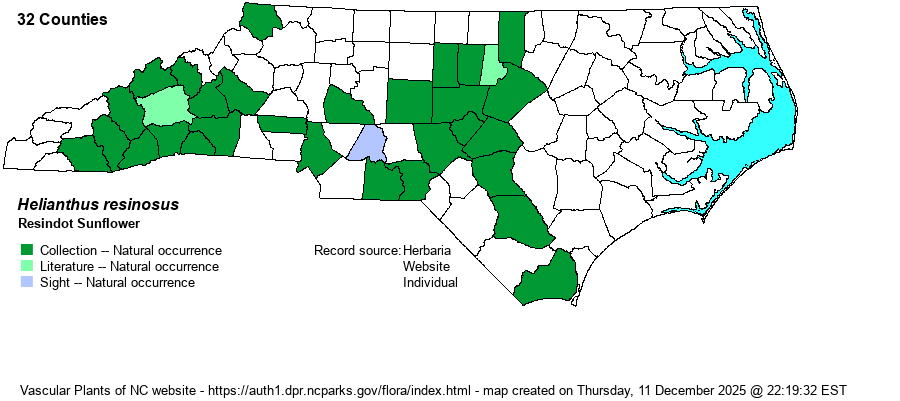| Author | Small | |
| Distribution | Southern and central Mountains, eastern and southern Piedmont, and locally on the Coastal Plain near the Cape Fear River. The gap between the Mountains and the northern half of the Piedmont appears to be real, but for unknown reasons.
NC to northern FL and MS. | |
| Abundance | Uncommon in the southern and central Mountains; rare to uncommon in the eastern and southern Piedmont, and locally uncommon in the southwestern Coastal Plain. | |
| Habitat | Mesic to dry woodlands, openings, wooded margins, and roadsides. The natural habitats in NC have not been described well, other than the "standard" dry and semi-wooded/edge habitats typical for most sunflower species. However, that "typical" habitat description does not account for the odd distribution and relative scarcity of the species. | |
| Phenology | Flowering and fruiting June-October. | |
| Identification | Plants are variable in height, from 2-7 feet, the stems often clumped together. Leaves are lance-shaped to ovate, scabrous above and soft hairy beneath, opposite on the lower part of the stem and alternate above. The key character of this sunflower is the abundant yellow resin dots or glands on leaves and heads. In addition, the flowers are very large for a native sunflower, often 3 inches across from ray tip to ray tip. This is not an overly familiar sunflower; check the leaf undersides for a soft, tomentose feel and the very larger flowers. | |
| Taxonomic Comments | Long known as H. tomentosus, but that name actually applies to another species.
| |
| Other Common Name(s) | Resinous Sunflower, Hairy Sunflower, Gray Sunflower | |
| State Rank | S3? [S3] | |
| Global Rank | G4G5 | |
| State Status | | |
| US Status | | |
| USACE-agcp | | |
| USACE-emp | | |

